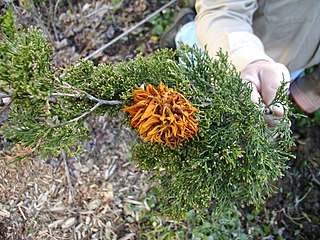
Gymnosporangium is a genus of heteroecious plant-pathogenic fungi which alternately infect members of the family Cupressaceae, primarily species in the genus Juniperus (junipers), and members of the family Rosaceae in the subfamily Amygdaloideae. The common name cedar-apple rusts has been used for these fungi. According to the Dictionary of the Fungi, there was 57 species in the genus. In 2023, Species Fungorum lists up to 74 species.

A heteroecious parasite is one that requires at least two hosts. The primary host is the host in which the parasite spends its adult life; the other is the secondary host. Both hosts are required for the parasite to complete its life cycle. This can be contrasted with an autoecious parasite which can complete its life cycle on a single host species. Many rust fungi have heteroecious life cycles:

Rusts are fungal plant pathogens of the order Pucciniales causing plant fungal diseases.
Specific replant disease is a malady that manifests itself when susceptible plants such as apples, pears, plums, cherries and roses are placed into soil previously occupied by a related species. The exact causes are not known, but in the first year the new plants will grow poorly. Root systems are weak and may become blackened, and plants may fail to establish properly.
Galls or cecidia are a kind of swelling growth on the external tissues of plants. Plant galls are abnormal outgrowths of plant tissues, similar to benign tumors or warts in animals. They can be caused by various parasites, from viruses, fungi and bacteria, to other plants, insects and mites. Plant galls are often highly organized structures so that the cause of the gall can often be determined without the actual agent being identified. This applies particularly to insect and mite plant galls. The study of plant galls is known as cecidology.

Joseph Charles Arthur was a pioneer American plant pathologist and mycologist best known for his work with the parasitic rust fungi (Pucciniales). He was a charter member of the Botanical Society of America, the Mycological Society of America, and the American Phytopathological Society. He was an elected member of both the American Philosophical Society and the American Academy of Arts and Sciences. He was a recipient of the first Doctorate in Sciences awarded by Cornell University. The standard author abbreviation Arthur is used to indicate this person as the author when citing a botanical name.

Juniperus sabina, the savin juniper or savin, is a species of juniper native to the mountains of central and southern Europe and western and central Asia, from Spain to eastern Siberia, typically growing at altitudes of 1,000–3,300 metres.
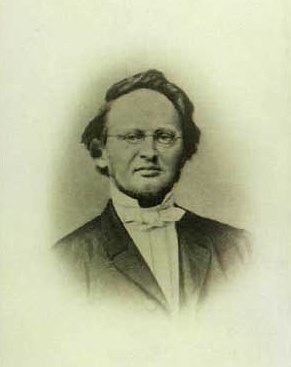
Anders Sandøe Ørsted, also written as Anders Sandoe Oersted or Anders Sandö Örsted was a Danish botanist, mycologist, zoologist and marine biologist. He was the nephew of physicist Hans Christian Ørsted and of politician Anders Sandøe Ørsted.

Gymnosporangium clavipes is a plant pathogen, a fungus that causes cedar-quince rust. Similar to Gymnosporangium juniperi-virginianae and Gymnosporangium globosum, the fungus infects a wide range of Rosaceae, such as apple, hawthorn and quince trees, and also requires an evergreen host such as eastern red cedar or a number of other juniper species to complete its life cycle.
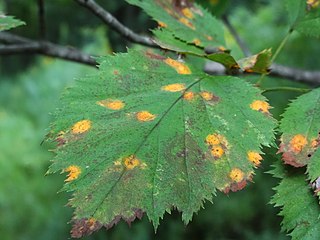
Gymnosporangium globosum is a fungal plant pathogen that causes cedar-hawthorn rust.

Gymnosporangium juniperi-virginianae is a plant pathogen that causes cedar-apple rust. In virtually any location where apples or crabapples (Malus) and eastern red cedar coexist, cedar apple rust can be a destructive or disfiguring disease on both the apples and cedars. Apples, crabapples, and eastern red cedar are the most common hosts for this disease. Similar diseases can be found on quince and hawthorn and many species of juniper can substitute for the eastern red cedars.
Gymnosporangium kernianum is a fungal plant pathogen.
Gymnosporangium nelsonii is a fungal plant pathogen found in North America.
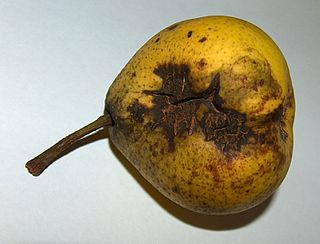
Venturia pyrina is a species of fungus in the family Venturiaceae. A plant pathogen, it causes scab or black spot of pear. It has a widespread distribution in temperate and subtropical regions wherever pears are grown.

Gymnosporangium sabinae is a species of rust fungus in the subdivision Pucciniomycotina. Known as pear rust, European pear rust, or pear trellis rust, it is a heteroecious plant pathogen with Juniperus sabina as the main primary (telial) host and Pyrus communis as the main secondary (aecial) host.

Telium, plural telia, are structures produced by rust fungi as part of the reproductive cycle. They are typically yellow or orange drying to brown or black and are exclusively a mechanism for the release of teliospores which are released by wind or water to infect the alternate host in the rust life-cycle. The telial stage provides an overwintering strategy in the life cycle of a parasitic heteroecious fungus by producing teliospores; this occurs on cedar trees. A primary aecial stage is spent parasitizing a separate host plant which is a precursor in the life cycle of heteroecious fungi. Teliospores are released from the telia in the spring. The spores can spread many kilometers through the air, however most are spread near the host plant.
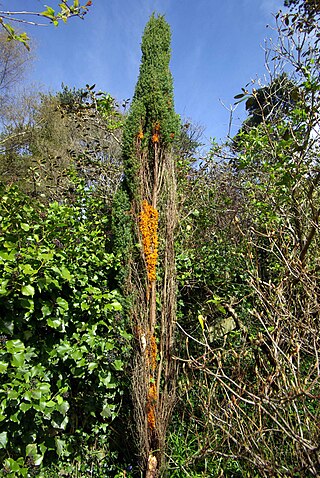
Gymnosporangium clavariiforme is a species of rust fungus which alternately infects Juniperus and hawthorns.
Aecidium mori is a species of fungus in the order Pucciniales. It can only be found on flowering plants of the species Morus, the mulberries. It is found in Asia.
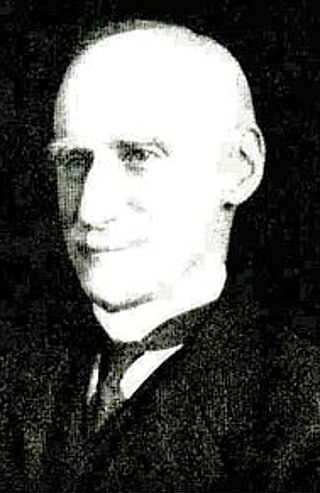
William Bywater Grove, was an English biologist, in particular a botanist and microbiologist. He is remembered in particular as a mycologist. He died in 1938 on the sixth of January when he was 89.
Frank Dunn Kern was an American plant pathologist and university administrator. He was a faculty member at Pennsylvania State University, holding appointments as Head of the Department of Botany and Dean of the Graduate School. He was an expert on the Pucciniales.

















